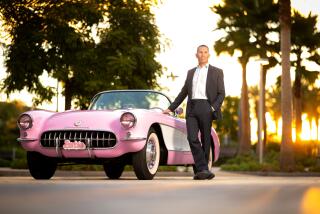Barbie’s Creator Has Died, but the Doll Has a Life of Her Own
- Share via
Malibu Barbie. Princess Barbie. Doctor Barbie. NASCAR Barbie. Army Barbie. Sleeping Beauty Barbie. Sign Language Barbie. President Barbie ...
Oh, how we have loved her. She has a horse, a camper, a dream house! She has a pink convertible and a fabulous wardrobe and oh, what a shoe collection! She even has a perfect boyfriend, the kind that can be parked in a shoe box for days, retrieved only in time to play “Saturday night date” or “Barbie goes to the prom.”
She is hated, too, of course. How could she not be? With that hair, those arched feet, that impossibly tiny waist ... those breasts.
Barbie is inescapable. She’s like Elvis, McDonald’s, the Yankees. An American icon. Sold in 150 countries, a $2.5-billion-a-year industry. Andy Warhol has a painting about her. The Smithsonian had an exhibit in her honor. There have been Barbie art exhibits at chic New York galleries. When Barbie first made her way to Moscow in 1992, little girls stood outside the city’s most famous toy store, transfixed by the mere sight of her.
“What they did was take a well-established play pattern--all the fantasies that girls had at that time--and made a three-dimensional character out of it,” says Gary Niles, who worked for 18 years at Mattel, which produces the doll. “How she became an icon, I don’t know. But she caught on.”
Barbie’s creator, Ruth Handler, died Saturday in Los Angeles at 85. She and her husband, Elliot Handler, co-founded Mattel with Harold Mattson.
As a young woman, Ruth was an entrepreneur far ahead of her time who found a niche in the toy market and turned it into a multibillion-dollar business. Later in life, after breast cancer and a mastectomy, she became an activist, making prosthetic breasts for cancer patients.
“How I identified her was not as the ‘Barbie lady,’” says Douglas Paul, Handler’s great-nephew, who works at the Securities and Exchange Commission. Paul and his four siblings lost their grandmother, Handler’s sister, when they were relatively young. Handler filled the void.
“We were at their house last August,” says Paul, referring to the Handlers. “Watching both my aunt and my uncle watch my kids with their Hot Wheels and their Barbies to me was fascinating. Here’s another generation of kids just mesmerized.”
“In the beginning, girls would pore over little booklets advertising Barbie outfits, debating which item to buy next. Fur stoles. Ball gowns. Wedding dresses--even though, after 41 years of dating, Ken still hasn’t proposed.
Of course, even in 1959, Barbie didn’t need a husband.
“There is an independence there, however weakly anchored,” says Mary Rogers, a University of West Florida professor of diversity studies and applied research, and author of “Barbie Culture.”
“She is her own person. She is not primarily somebody else’s partner. She is not primarily somebody else’s mom. She is not primarily somebody else’s right-hand person. She is kind of unto herself....I think that independence is where some of her subconscious appeal is for young girls.”
Of course, Barbie has had her image problems. Feminists, and some health care advocates concerned with body image issues, decry her proportions. There’s that sticky little question of how, exactly, all her internal organs would fit if she were translated into a 5-foot-6-inch teenager--with proportions of 39-21-33. Teen Talk Barbie upset educators when one of her phrases happened to be “Math class is tough,” a sentence that many saw as reinforcing the stereotype of girls’ aversion to math.
In 2000, Barbie got a make-over, primarily to eliminate that waistline “seam” that was always there to make her more poseable. Her new body is a little more athletic, a little less bright-eyed, a little less beach blond and a little less ... va-va-va-voom. The breasts shrank. A little. So did the hips.
The game remains the same. Make-believe. Pretend. Dress up. These are at the core of little-girl games, and Mattel has stacks of research to prove it. Malibu Barbie and her friend Skipper go to the beach. Barbie is the teacher, and she fails Ken in English. Fashion Plate Barbie goes to a photo shoot, after a full day at the beauty salon. Marine Barbie saves the world!
More to Read
Inside the business of entertainment
The Wide Shot brings you news, analysis and insights on everything from streaming wars to production — and what it all means for the future.
You may occasionally receive promotional content from the Los Angeles Times.










